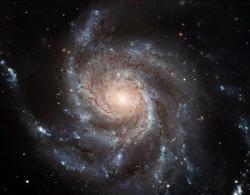 The most detailed image ever made of a spiral galaxy has been compiled from 51 Hubble Space Telescope images. It may shed light on the cause of mysteriously bright X-ray emissions in the galaxy and has already revealed a stellar nursery where no stars were expected to form.
The most detailed image ever made of a spiral galaxy has been compiled from 51 Hubble Space Telescope images. It may shed light on the cause of mysteriously bright X-ray emissions in the galaxy and has already revealed a stellar nursery where no stars were expected to form.About 10 years of observations with Hubble, as well as images from powerful ground-based telescopes such as the Canada-France-Hawaii Telescope in Hawaii, US, were superimposed to create this image of the Pinwheel Galaxy, or M101.
The galaxy is 170,000 light years across – nearly twice the size of the Milky Way – and takes up an area of the sky equivalent to one-fifth the size of a full Moon. It lies about 25 million light years from Earth – about 10 times as far as our nearest large neighbour, the Andromeda galaxy.
At that distance, Hubble can still resolve individual stars. "But if you get much further away than M101, it can't," says Kip Kuntz, an astronomer at NASA's Goddard Space Flight Center and Johns Hopkins University, both in Maryland, US.
No comments:
Post a Comment